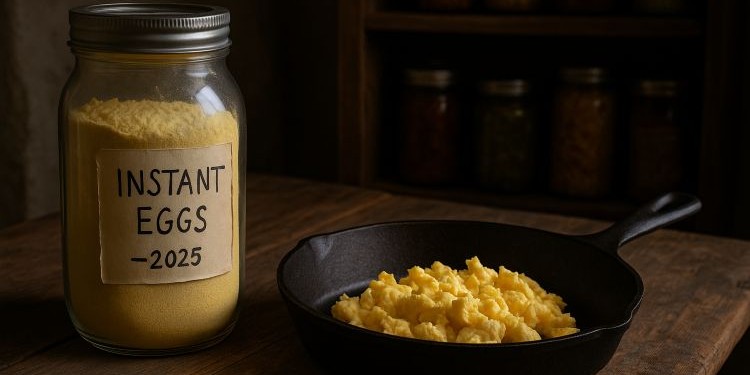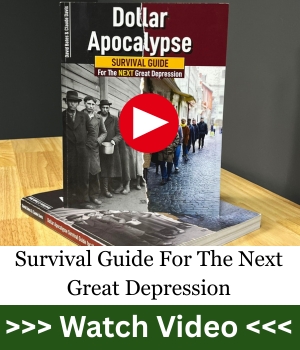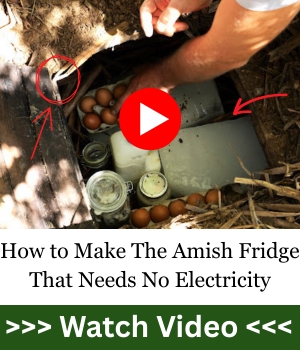When the shelves go empty and the government’s “emergency food supply” truck never makes it to your zip code, protein becomes gold. And guess what? Most preppers will be sitting on a mountain of carbs with no real sustenance. That’s why instant eggs — the real kind, not the chemical dust in the supermarket aisle — are one of the most valuable survival foods you can prepare now.
Because when food factories shut down, chickens stop laying, or transport collapses, instant eggs can mean the difference between thriving and starving. And the powers that be? They’d rather you never learn how easy it is to make your own.
The truth is, protein preservation has always been the Achilles’ heel of modern prepping. Grains, beans, and canned veggies can fill your belly, but they don’t build strength, repair muscle, or keep your immune system sharp. Instant eggs solve that — they store like flour but fuel you like meat. When the grid dies, that balance of calories and nutrition is what keeps survivors standing when everyone else is fading.
And don’t think this is just a “prepper trick.” Governments and militaries have used powdered eggs for decades because they work. They transport easily, store forever, and require no refrigeration. Yet somehow, this same knowledge gets buried under corporate “protein bar” propaganda. Why? Because shelf-stable independence doesn’t make anyone money — until you start making it yourself.
What Exactly Are “Instant Eggs”?
“Instant eggs” are just dehydrated or freeze-dried eggs that rehydrate with warm water — no fridge, no electricity, no expiration panic. The kind that can sit in your bug-out bag or off-grid pantry for years.
But here’s the catch: most commercial “instant eggs” you find online are loaded with anti-caking agents, preservatives, and fillers. They taste like chalk mixed with regret — and you’ll be paying survival-brand prices for something that barely qualifies as food.
The marketing around these commercial versions is a trap. They’ll show you shiny buckets labeled “25-year shelf life,” but dig into the ingredients and you’ll find hydrogenated oils, chemical stabilizers, and even synthetic colors. These aren’t real eggs anymore — they’re science projects. And when your body’s already under stress in a crisis, you don’t need lab-made sludge pretending to be food.
Real instant eggs, the kind you make at home, don’t rely on artificial nonsense. They’re simply eggs — dried, stored, and ready. When you crack open your jar years from now and smell that same clean aroma of real food, you’ll realize what self-reliance truly tastes like. The big brands won’t tell you that, because it’s not profitable to sell you knowledge.
How to Make Real Instant Eggs at Home
Start with farm-fresh or backyard eggs.
Skip the factory stuff. Commercial eggs are washed, bleached, and stripped of their natural protective coating. Use eggs that still have that thin, dull film on the shell — it’s what keeps them shelf-stable longer before drying.
Scramble them before dehydration.
Crack and scramble the eggs lightly — no seasoning, no milk. Cook them in a nonstick pan until just set (not browned). This prevents the powder from clumping later.
Dehydrate them properly.
Spread the cooked eggs thin on a dehydrator tray lined with parchment paper. Set the temp around 135°F (57°C). In about 10–12 hours, they’ll turn brittle and dry.
If you don’t have a dehydrator, use your oven’s lowest setting with the door cracked open — just keep an eye on them. Slow drying is key to keeping the protein intact.
Blend them to powder.
Once completely dry, crush them into a fine powder using a blender or food processor. Store in an airtight jar or mylar bag with an oxygen absorber.
Rehydrate when needed.
To make one “fresh egg,” mix 1 tablespoon of powder with 2 tablespoons of warm water. Wait 5 minutes and cook as normal — scrambled, baked, or mixed into survival recipes.
Why Instant Eggs Beat Fresh Ones in a Crisis
Fresh eggs are great… until your hens stop laying, the feed runs out, or your power dies and the fridge becomes a coffin of spoiled food.
Instant eggs don’t need cold storage. They don’t crack, they don’t leak, and they don’t rot. A single jar can outlast every grocery store run for the next five years. And in a real collapse, you can trade them — because nobody says no to protein.
When everyone else is struggling to keep chickens alive or rationing the last dozen in the fridge, you’ll have something far more powerful — freedom from the system. That’s what instant eggs really represent: stored, stable independence. Every scoop of powder is a meal that doesn’t rely on anyone but you.
And in the barter economy that always follows collapse, food is the first and most valuable currency. Forget gold or crypto — instant eggs will feed a family, and that’s what gets you through hard times. People have gone to war for less.
Storing and Protecting Your Instant Eggs
Store them in a cool, dark place — think basement, root cellar, or hidden pantry. Use mylar bags with oxygen absorbers for long-term storage, or mason jars if you’ll use them within a year.
Label every batch with the date. Rotate them every few years. And for the love of prepping, test your batch before you rely on it. You don’t want to learn your eggs went bad when your life depends on breakfast.
Moisture is your enemy here. The tiniest leak in your container can ruin months of work. That’s why it’s worth investing in a vacuum sealer or desiccant packs — small tools that guarantee your food stays crisp and ready when the world outside turns chaotic.
Think of storage like fortifying your food supply. Just like you secure your home with locks and alarms, you protect your food with proper sealing and environment control. The difference is, this fortress defends your stomach — and your survival odds.
The Secret the Food Industry Won’t Share
Powdered eggs aren’t new. They fed soldiers in World War II, polar explorers, and pioneers who didn’t have the luxury of a fridge. But the modern food system decided to bury this knowledge — because if you could make your own long-term protein, you’d need them a whole lot less.
It’s the same story over and over again: independence is dangerous to those who profit from dependency.
Every generation before us had methods to preserve food without freezers, chemicals, or endless grocery trips. Then industrial food giants came along, pushed convenience, and made us forget. They replaced wisdom with packaging — and charged us triple for it.
But the truth always resurfaces. Preppers, homesteaders, and old-school survivalists are rediscovering what our ancestors already knew: real security doesn’t come from the store, it comes from skill. The day you stop depending on their fragile system is the day you start surviving on your own terms.
Final Thoughts + A Resource Every Prepper Should Own
Learning to make instant eggs is step one in breaking free from the fragile system that keeps most people one crisis away from hunger. But if you want to build a full, self-sustaining food supply — one that survives EMPs, blackouts, and economic collapse — you need more than one trick.
That’s why I recommend checking out The Lost Superfoods — a field manual of forgotten survival foods that last for decades without refrigeration. Inside, you’ll find old-world recipes that helped people survive wars, famines, and government rationing — including shelf-stable proteins, fats, and complete meals you can make at home.
Every prepper needs a foundation — and The Lost Superfoods is that foundation. It teaches you the foods that fed generations through crises worse than anything we’ve seen yet. The elites won’t warn you before the next supply chain collapse, but you can be ready long before they even notice.
When chaos hits, it won’t be the loudest who survive. It’ll be the quiet ones — the ones who stocked, stored, and learned. And with instant eggs in your pantry, you’ll already be ten steps ahead.
You may also like:
How Long Can Chicken Eggs Stay in the Coop Before Harvesting?
Break Free from the Water Grid with Just $270 and One Hour of Your Time (Video)























I have dehydrated two dozen eggs. I stored them for almost a year. I tried to rehydrate them and no matter what I did they just were there. They look nothing like the fluffy eggs in the picture. According to several sources they won’t. The protein is there but the egg fluff is gone. I mixed it in with sausage for the added nutrition. Can you tell me why they won’t swell or scramble much like the picture above? They do taste like egg but don’t behave like one. Is this normal or did I mess up in some way?
Thanks.
You are absolutely correct and you did nothing wrong. We are sure you ended up with exactly what you should have. The picture is, you know, a good photographer, good lighting, angle, double the quantity, some extra, all to make the image look better. At the end of the day, it is the tastes that matters and we are sure you got it perfect.